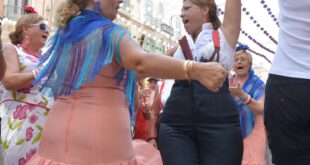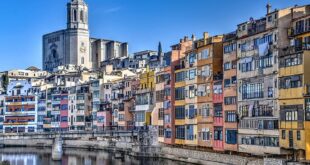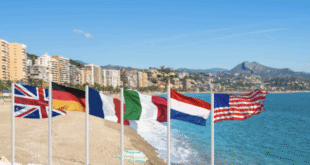After two days of trying to find elusive whales on a British ferry in the Bay of Biscay, I needed some solid ground to stabilize my legs as well as some good Spanish food and culture in order to reset my senses.
On the docks in Bilbao I picked out a location on a map. On a two-day drive down to Andalucía, Toledo, situated bang slap in the middle of the Iberian Peninsula, seemed as good a place as any.
The vast expanses of Castilla La Mancha make one feel small. The modern motorway system makes it possible to travel across vast landscapes. I was able pass Madrid early in the afternoon. The view of Toledo on a hill in the distance was similar to what travellers have been seeing for centuries.
Few foreigners are familiar with Toledo. It’s true, I saw just a few of them during my 24 hour stay in the most royal city of Spain. The city doesn’t really like foreigners. Menus remain in Spanish. Thankfully, it is Spanish tourists who are keeping this place alive.
Food for the Soul
I chose a room in the suburbs, near the bullring. After a short siesta, I set out to explore the city on foot and make the most of the brief time that I had. The old walled-city is a UNESCO World Heritage Site and is accessible along a wide avenue bordered with flower-filled parks.
As you pass through the massive stone gates, it is easy to imagine the battles fought in the past for this citadel city that has played a prominent role in Iberian history. Hispanic Romans built an Iberian Capital here, after finding the area suitable. Later, the Catholic Visigoth King lived here. Their empire fell apart and left them vulnerable to Moors who invaded the area in the eighth Century.

After the Catholics had retaken the city, Pope Pius XI recognised it as the seat of Christianity in Spain. After a period of calm, Muslims, Jews and Christians lived in harmony until Ferdinand and Isabella imposed their fiery theological dictatorship on Spain and forced converts began. After this, Toledo fell into a downward spiral and its capital was relocated to Madrid.
The day I needed lunch, I didn’t care much about history. I was hungry. After two weeks in England, I began to realize that living in Spain had made my body reorganise at a molecular base level. I craved Spanish food like a drug addict craves needles. After wandering around a maze of narrow streets, I came across a seemingly innocuous stone entrance with a brass menu. Perfect. As I stepped inside, I was amazed to see a large courtyard in the Spanish colonial style. The porticos were supported by huge Corinthian column. It was packed with people who were on to something good. I took a chair.
Menu consisted of chicken muslos in chilindron, watermelon slices and delicately cooked rice with meat. A rich, fruity red wine and home-made bread perfected a meal that set me back €11. The Ramadan of my ferry journey was a disappointment (overcooked roast beef, potatoes?) I would rather eat crisps than roast beef. I was in Spanish culinary heaven.
So fortified, i set off to explore the city. A city situated on a hill, with a flowing river on all three sides, makes for an exhausting peregrinatory walk. In a medieval city you don’t need a map unless it is a real challenge. You should just dive right in. Let curious alleys take you on a journey, let alluring views tempt your up steps, and let enticing bars and shops consume you. It is impossible to drive on most of the streets, but the mopeds are everywhere.
I had a hastily thrown-together itinerary, and the cathedral was one of my must-see stops. The richness and opulence of the decoration in the cathedral was something that I had never seen before. No expense was spared to make this temple of awe awe-inspiring enough to intimidate the peasants into submission.
A knight in shining armour
After I emerged stiff-necked, humbled and awed by the divine serenity of such buildings (even atheists can feel it), I headed to the bar and topped up my sin level. The Plaza de Zocodover in the Old Town is the epicenter of the town. There are several outdoor bars where you can drink beer and enjoy marzipan. Toledans love marzipan. Many windows feature the sweet almondy paste in various artistic forms.
The knights can be seen standing sentinels on most streets. The warriors in the olden days are silver and have stiff backs. They hold pole axes, swords, and sellotaped notices on their chests say “No Tocar”. It was like a challenge, so I reached out and touched one. I half expected him to step up and tear my troubadour’s chulo apart, but when he raised his visor he was as hollow as an empty political promise made at a party convention. The majority of these knights with empty chests were guarding shops that sold a wide range of medieval armoury. These shops sold authentic broad swords, spiked mallets, maces and iron maidens. Toledo will become the arms fair for the world if a future battle is medieval.
In the fading sun, I made my way out of the city to the river that cuts a small canyon at the base. The wild partridges, who darted into the undergrowth to hide, seemed to lead remarkably uninhibited lives. This is ironic, considering this is Toledo’s favourite bird and is on most menus. The river is clear and glassy, and you can view the glory of Toledo from its banks. The setting sun turns the walls of sandstone structures to gold.
Later, I went to another restaurant and sat outside on a busy street. I was able to listen in on a group Harvard professors, American tourists on a Grand Tour. They were sitting at a table nearby. One of them said “I don’t care where else we go as long as we see Granada, Seville and Órgiva,” I did a double take. Did I hear right? He went on to explain to his travelling companions that Órgiva was “zany little town” where a “crazy English guy” lives with a flock of sheep and a parrot. I could see that his traveling companions did not like the idea. But the professor, with his grey beard, was determined to pursue his plan.
The streets take on an almost medieval look at night. The flickering flames from the torches illuminate some streets, while the gray cobbles are turned black. I entered the maze at the top of the hill to search for the bizarre. Soon I found the bar: Toledo’s one and only British pub. This was not your typical Brit bar. It was themed after the British colonial period and run by Spaniards. No, they hadn’t heard of a bitter.
Every wall was filled with oddities from an era when the majority of the map was in pink and the best Zulu you could find was a dead Zulu. Elephant heads, Hindu sculptures, and pictures of Raj era crickets, tiger, and cricket skins were all displayed on the walls. As I sipped on my (Spanish-language) beer, I wondered if I was not in some Alice in Wonderland fantasia.
A thick glass window was under my feet. Peering in, I could see stone steps and smoky brass cauldrons. It was either Hades or a microbrewery. As I left the bar, I took a few side streets and became disoriented. I then retraced all my steps. The bar was no longer there. It was gone.
You are challenged to find it if you’re planning to go to Toledo. You can also keep it a secret if you manage to find it by accident.
READ MORE
The Olive Press Travel News: Click Here to Read More.
 Costa News Spain Breaking News | English News in Spain.
Costa News Spain Breaking News | English News in Spain.






